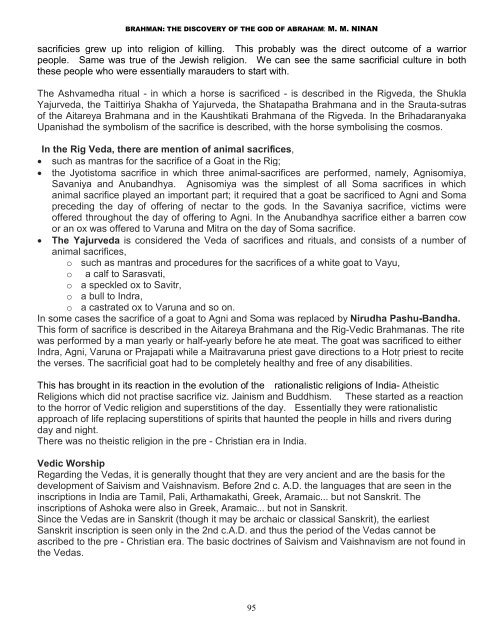You also want an ePaper? Increase the reach of your titles
YUMPU automatically turns print PDFs into web optimized ePapers that Google loves.
BRAHMAN: THE DISCOVERY OF THE GOD OF ABRAHAM: M. M. NINAN<br />
sacrificies grew up into religion of killing. This probably was the direct outcome of a warrior<br />
people. Same was true of the Jewish religion. We can see the same sacrificial culture in both<br />
these people who were essentially marauders to start with.<br />
The Ashvamedha ritual - in which a horse is sacrificed - is described in the Rigveda, the Shukla<br />
Yajurveda, the Taittiriya Shakha of Yajurveda, the Shatapatha <strong>Brahman</strong>a and in the Srauta-sutras<br />
of the Aitareya <strong>Brahman</strong>a and in the Kaushtikati <strong>Brahman</strong>a of the Rigveda. In the Brihadaranyaka<br />
Upanishad the symbolism of the sacrifice is described, with the horse symbolising the cosmos.<br />
In the Rig Veda, there are mention of animal sacrifices,<br />
• such as mantras for the sacrifice of a Goat in the Rig;<br />
• the Jyotistoma sacrifice in which three animal-sacrifices are performed, namely, Agnisomiya,<br />
Savaniya and Anubandhya. Agnisomiya was the simplest of all Soma sacrifices in which<br />
animal sacrifice played an important part; it required that a goat be sacrificed to Agni and Soma<br />
preceding the day of offering of nectar to the gods. In the Savaniya sacrifice, victims were<br />
offered throughout the day of offering to Agni. In the Anubandhya sacrifice either a barren cow<br />
or an ox was offered to Varuna and Mitra on the day of Soma sacrifice.<br />
• The Yajurveda is considered the Veda of sacrifices and rituals, and consists of a number of<br />
animal sacrifices,<br />
o such as mantras and procedures for the sacrifices of a white goat to Vayu,<br />
o a calf to Sarasvati,<br />
o a speckled ox to Savitr,<br />
o a bull to Indra,<br />
o a castrated ox to Varuna and so on.<br />
In some cases the sacrifice of a goat to Agni and Soma was replaced by Nirudha Pashu-Bandha.<br />
This form of sacrifice is described in the Aitareya <strong>Brahman</strong>a and the Rig-Vedic <strong>Brahman</strong>as. The rite<br />
was performed by a man yearly or half-yearly before he ate meat. The goat was sacrificed to either<br />
Indra, Agni, Varuna or Prajapati while a Maitravaruna priest gave directions to a Hotṛ priest to recite<br />
the verses. The sacrificial goat had to be completely healthy and free of any disabilities.<br />
This has brought in its reaction in the evolution of the rationalistic religions of India- Atheistic<br />
Religions which did not practise sacrifice viz. Jainism and Buddhism. These started as a reaction<br />
to the horror of Vedic religion and superstitions of the day. Essentially they were rationalistic<br />
approach of life replacing superstitions of spirits that haunted the people in hills and rivers during<br />
day and night.<br />
There was no theistic religion in the pre - Christian era in India.<br />
Vedic Worship<br />
Regarding the Vedas, it is generally thought that they are very ancient and are the basis for the<br />
development of Saivism and Vaishnavism. Before 2nd c. A.D. the languages that are seen in the<br />
inscriptions in India are Tamil, Pali, Arthamakathi, Greek, Aramaic... but not Sanskrit. The<br />
inscriptions of Ashoka were also in Greek, Aramaic... but not in Sanskrit.<br />
Since the Vedas are in Sanskrit (though it may be archaic or classical Sanskrit), the earliest<br />
Sanskrit inscription is seen only in the 2nd c.A.D. and thus the period of the Vedas cannot be<br />
ascribed to the pre - Christian era. The basic doctrines of Saivism and Vaishnavism are not found in<br />
the Vedas.<br />
95


















